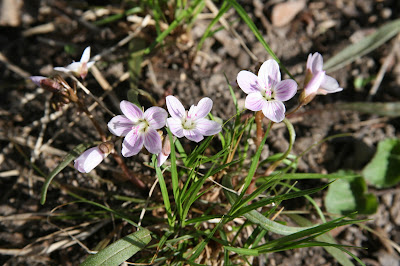Canopy Trees
 |
| Sugar Maple (Acer saccharum) |
 |
| American Beech (Fagus grandifolia) |
Other common trees in the American Beech/Sugar Maple Forest include:
 |
| American Basswood (Tilia americana) |
 |
| Black Cherry (Prunus serotina) |
 |
| Black Walnut (Juglans nigra) |
 |
| Bur Oak (Quercus macrocarpa) |
 |
| Chinquapin Oak (Quercus muehlenbergii) |
 |
| Red Maple (Acer rubrum) |
 |
| Northern Red Oak (Quercus rubra) |
 |
| White Oak (Quercus alba) |
 |
| Eastern White Pine (Pinus strobus) |
In more northern regions, the American Beech is gradually replaced by the Eastern Hemlock (Tsuga canadensis) as one of the two co-dominant species. Because Mid-Michigan sits on this transition zone between the American Beech/Sugar Maple and Sugar Maple/Hemlock Forest types we have a forest type that combines the two - the Beech/Maple/Hemlock Forest.
 |
| Eastern Hemlock (Tsuga canadensis) |
The majority of wildflowers that grow within the American Beech/Sugar Maple Forest are spring ephemerals. They bloom (and often die back) before the canopy fully leafs out in the Spring.
 |
| Large-flowered Trillium (Trillium grandiflorum) |
 |
| Common Blue Violet (Viola sororia) |
 |
| Downy Yellow Violet (Viola pubescens) |
+9.jpg) |
| Dutchman's Breeches (Dicentra cucullaria) |
 |
| Spring Beauty (Claytonia virginica) |
+1.jpg) |
| Cut-leaved Toothwort (Cardamine concatenata) |
 |
| Wild Blue Phlox (Phlox divaricata) |
 |
| False Rue-anemone (Enemion biternatum) |
 |
| Wild Geranium (Geranium maculatum) |
 |
| Blue Cohosh (Caulophyllum thalictroides) |
 |
| Blue-stemmed Goldenrod (Solidago caesia) |
+1.jpg) |
| Wild Ginger (Asarum canadense) |
.jpg) |
| Wild Leek (Allium tricoccum) |
 |
| Beech-drops (Epifagus virginiana) |
 |
| Yellow Trout Lilly (Erythronium americanum) |
No comments:
Post a Comment